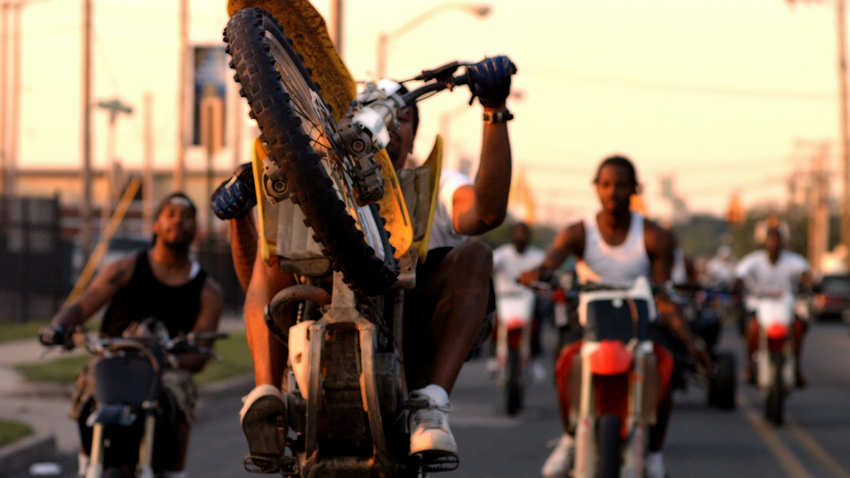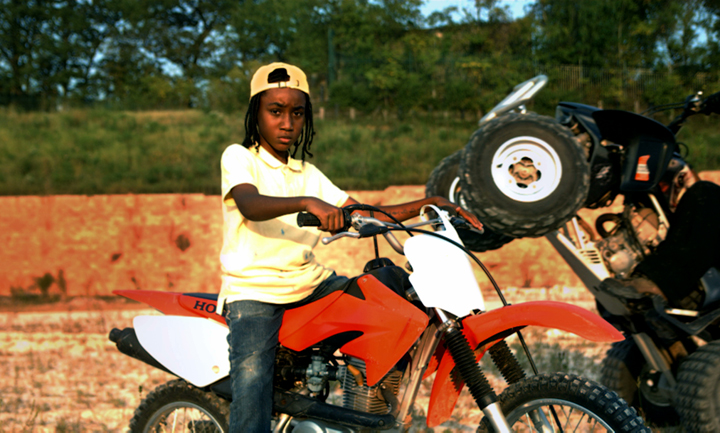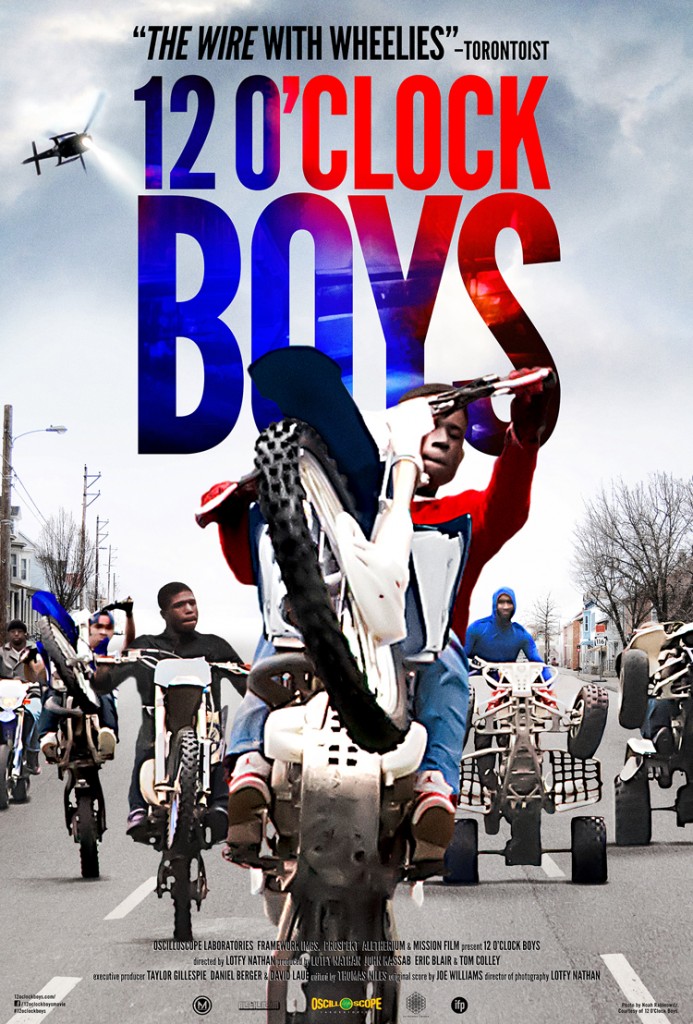
by Curtis Caesar John
Filmed with striking cinematography and starring a diminutive protagonist who makes the reckless yet admittedly exciting sport much more palatable, 12 O’Clock Boys, the first theatrical documentary focusing on the notorious Baltimore city urban dirt bike pack phenomenon, is as dynamic as it questionably exploitative.
Directed by first-time feature film director Lofty Nathan, 12 O’Clock Boys follows teenager Pug, a thirteen year-old very small for his age but grown in spirit and attitude. For three years we see Pug as he follows the exploits of the world-famous 12 O’Clock Boys as they ride the streets popping wheelies – the height they reach in doing so evokes the hands of a clock at 12 o’clock, hence their name – and weaving at excessive speeds through traffic, impressively eluding the frustrated police. For Pug, who hates regular school but is extremely bright in his understanding of animals, nature, and of course bike riding and mechanics, the Boys are heroes and he’ll do anything to join their ranks.
Like hip-hop and other once underground expressionistic forms, the dirt bike riders provide their own means of community, escapism and camaraderie sans recreation centers and meaningful after-school activities to stimulate their minds and keep them active and out of trouble. Despite dirt bike street-riding being against the law and extremely dangerous to pedestrians and moving vehicle drivers, the boisterousness of these young men is attractive and to Pug and other young men, the lure of that against the ‘get money’ temptation of more illegal street activities is understandable. In this way its reminiscent of Sarah Blecher’s 2010 documentary Surfing Soweto, about alienated young men in the poor South African city of Soweto who take to riding on top of trains to feel alive. Similarly, the riding and the tricks are hazardous to others, but one can make the argument (though the film does not) that reckless car driving – whether its high speed racing on public streets or just an idiot or out of control driver – is even more so.

Nathan caught wind of the 12 O’Clock Boys while attending art school in Baltimore and seeing them speed by once in a while, but being unaware of who they really are in the protected bubble of his school life. After finding out where they all hang out, he befriended some of them and for a class project began shooting action-filled footage of their riders, in which we can assume was in higher-quality than their amateur YouTube footage. He eventually met Pug and realized that his perspective would be ideal in presenting the Boys’ story to the world. From this respect however the film has some exploitative tendencies, as it not only uses a little kid to present the life of more seasoned riders but also glamorizes Pug’s, his mother Coco’s, as well as other subjects, unfortunate ghetto behavior (though not relegated to urban centers, the word ‘nigger’ is also thrown about more times than in Django Unchained – and that is a lot). The behavior is real in that it is their story and the way they are living, and it is clear that many of them would rather live life in less dangerous neighborhoods, but it romanticizes ghetto life and the hazardous life these young men have chosen to lead.
Though he makes up for it late in the film, earlier on Nathan wisely chooses to focus on Pug’s fascination with the 12 O’Clock Boys and his tenacity at enhancing his riding skills, which begin on a mini-four wheeler and graduate to an actual dirt bike, instead of the inherent danger; in his own way Nathan allows viewers to focus on Pug’s story, including Coco’s exasperation at Pug’s enthrallment of the streets and the attractiveness of the pack. The director also rightly acts as a fly on the wall of Pug’s and the life of the 12 O’Clock Boys, his voice or presence scarcely present unless he’s trying to get something more out of Pug, who as he grows more confident is also more combative to Nathan and everyone not involved in bike riding.
One can imagine that adventure junkies will get a kick out of the film the same way the subjects in the film like Wheelie Wayne, the most famous of the riders, and others in the dirt bike community do at watching other riders do tricks. Is what they do any more personally hazardous than rock climbing, running with the bulls, X Games like competitions, and other extreme sportsmen-like exploits? The answer clearly is no, but like some of the others is mired in a sea of grey when people who would rather have nothing to do with them become the victim of their game. While even the movie poster promotes the film as “The Wire with Wheelies,” it really has no story-wise connection whatsoever with the HBO show other than location and perhaps groups/gangs serving as surrogate families, so please resist the temptation to think of it as so.
12 O’CLOCK BOYS
Directed by: Lotfy Nathan
Produced by: Lotfy Nathan, Eric Blair, Taylor Gillespie, John Kassab
Release Date: January 31st, 2014 (In Theaters and on Demand / Digital)
Running Time: 75 mins
RELATED LINKS:
- 12 O’Clock Boys website
- Oscilloscope Laboratories website
- New York Times article: Riding with the 12 O’Clock Boys


